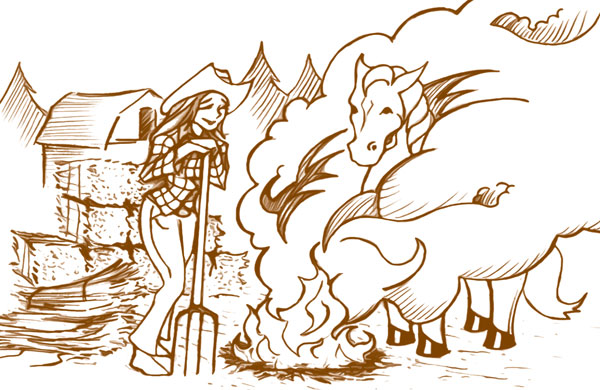
Insect Relief for Your Herd
There is a simple, inexpensive method to give your livestock some relief from flies and mosquitoes. It’s called smudge-burning, and every owner should be well-schooled in this fine art.
A smudge is a slow-burning, smoke-producing fire. When used properly, it can eliminate the irritation and suffering caused by flying insects as smoke is an effective method to quickly rid an area of flies, mosquitoes and other flying insects.
The first thing to do as a smudge-operator is to check with your local authorities on burning by-laws if you live in a smaller rural area. You may be required to hold a permit and have your smudge smoldering during restricted times.
The next step is to select a safe area for burning. This may be the center of an empty slough, or a cleared area free of grass or trees and away from bale stacks or buildings. A tilled or cultivated area of pasture large enough to accommodate a smudge for your number of animals is ideal. A water supply, close at hand is preferable as well. Except for emergencies, you shouldn’t need the water unless you are planning to be away while the smudge is still smoldering. Then it should be extinguished.
Next you will need some old straw bales?—?several square or one round. These bales must be thoroughly wet and preferably rotted as they are better smoke producers. As you will only use the equivalent of one square bale every time you light a smudge, ensure the extra straw is well away from your lighting area.
Now for the art of preparing the perfect smudge! First, you’ll need a medium to thick layer of dry straw. This layer can be anywhere from two to six feet in circumference, depending on how large you want the smudge?—?this will depend on the size of your herd. Second, place an easy-to-light substance (such as an old newspaper) in the center of your bottom layer. This substance ensures quick-lighting as your dry straw may be partially damp. Your next step is to bring a supply of wet straw close to your smudge as you will be layering it as the fire spreads. Then, put a match to your paper and wait until the flames have caught the layer of straw beneath it. After it is burning well (do not let it completely burn away), start setting a fairly thick layer of wet straw on top of the flames, a bit at a time, with your pitchfork. Do this carefully, making sure you do not completely smother the burning embers of the bottom layer. Now, stand back and admire your work. If you feel there isn’t enough smoke, simply lift your smudge underneath with the pitchfork, allowing oxygen to enter and encourage spark. A good smoke-producing smudge should last several hours.
The fine art of smudge-burning becomes better with practice. Don’t feel discouraged if your first attempt only results in a sickly, thin trickle of smoke and all the mosquitoes land on you in retaliation. With the first couple of attempts, you may also find that your hard work has resulted in the animals completely ignoring the smoke. Do not despair as horses can be easily trained to stand in the smoke. Pick your bravest steed and lead him through it a few times. He will quickly realize that when standing in the smoke he’s no longer being tormented by flies and mosquitoes–others will naturally follow suit. Before you know it, your animals will be milling excitedly around you, eagerly awaiting that smoothing smoke. Cattle will take a little longer to gravitate toward a smudge but it works very well for them too.
As for when to light a smudge, the heat of the day and early evening would be ideal. However you may feel twice a day is a bit too much like another full-time job. Choose the evening if you are going to “light up” just once per day as this is when mosquitoes are at their worst.
Another advantage to smudge-burning is that it helps to dispose of old straw that accumulates over the years. Rest assured you are doing no environmental damage as straw is clean-burning and emits no harmful toxins.
Above all, use care when lighting a smudge and never leave one smoldering if you are planning to be away. It can easily get out of control, particularly in high winds if not checked frequently.
The next time you see your animals tormented by flies and mosquitoes, help alleviate their suffering. Take a few minutes to go out and produce a good smoker for them. The result will be contented, relaxed animals.
Six Steps to Relief
1. Select a cleared area away from bale stacks or buildings.
2. Select old bales?—?some dry and some wet or rotted.
3. Build a medium to thick layer of dry straw and newspaper.
4. Light the paper and once the straw is burning well, start layering wet or rotted straw carefully on top without smothering the flames.
5. Finish by ensuring you have enough heat generated by lifting the wet layers gently to allow oxygen to reach the drier layers beneath.
6. It takes a bit of practice but once you have the method mastered, you should have a good smoke-producing smudge that lasts several hours.
